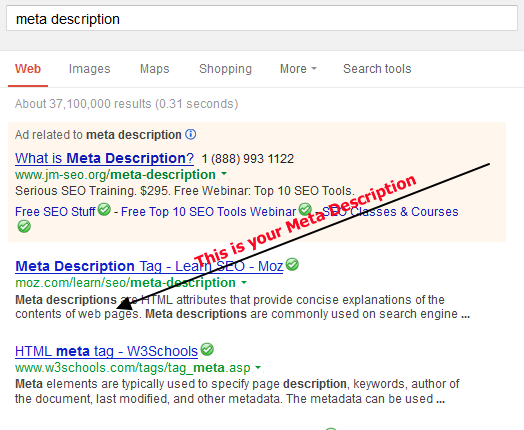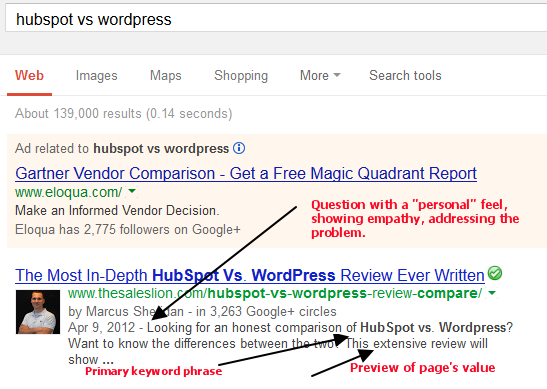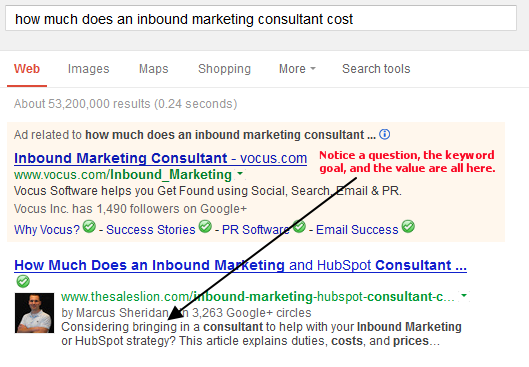Topics:
Content MarketingSubscribe now and get the latest podcast releases delivered straight to your inbox.
How to Write Great Meta Descriptions That Increase Your Clicks and Conversions

Mar 13, 2018

A couple of quick points to make sure we’re on the same page to start this article…
- SEO is not going anywhere anytime soon, so we may as well embrace it, especially considering a business’ sales can rise or fall by millions of dollars based on search engine results. This being said, it’s critical that we all understand how to write great blog titles, meta descriptions, proper URLs, header tags, etc.—and not just create great content. (As I’ve said before, if you’re striving for “great content” without paying close attention to SEO opportunities as well, you’re foolish for not striving to achieve your potential.)
- The most common SEO mistake we see from businesses looking to embrace blogging and better content marketing is bad titles. Write great blog titles and you'll get great results
- The second most common SEO (or back-end) mistake businesses make with their content (other than bad content itself) is the issue of writing poorly formed meta descriptions, which will be the central theme to this post.
What is a Meta Description?
In simple terms, a meta description is an HTML tag that is used to describe a web page/blog article (same thing) in snippet form, and can be customized quite easily on most platforms, especially with Wordpress, by simply using something like the All-in-One-SEO Pack. There are 3 places each of us see meta descriptions every day, making their proper structure and styling all the more important:
- In search engine results, underneath the page title and URL—and something most searchers (that would be you and me) briefly review so as to confirm our decision to “click” (or not click) a particular page. ***Note: Although a Meta Description isn’t necessarily about “SEO” per se, it can have a dramatic effect on click through rate, which is exactly why it merits our serious attention. [More Clicks=More Visits=More Social Shares and Links=Better SEO]
- In social media settings where, when sharing a page of a site, the description is shown.
- In social bookmarking sites, where as with social media, meta descriptions are often used with content snippets.
 Without many of us even realizing it, Meta Descriptions affect our actions (and spending) online each and every day throughout the world, thus meriting our serious attention.
Without many of us even realizing it, Meta Descriptions affect our actions (and spending) online each and every day throughout the world, thus meriting our serious attention.As I look around the web each day, I’m amazed at how many people and businesses miss the mark when it comes to the proper writing of meta descriptions, which is exactly why I wanted to show a very simple and effective method for writing a great one with today’s post.
Talk to Me, Make it about My Problems, Then Solve My Problems
Quick question for you, and it’s a tough one…
Why do people use search engines (Google)?
1. Because they want to solve their problem in that moment.
or
2. Because they want to be sold something, and hear about how awesome your company is.
OK, so it wasn’t such a tough question, but hopefully you get the point—people use search engines to get answers and solutions, and their ability to gauge whether or not a website does that generally starts with the page title, the URL, and the meta description they see in search engine results.
That being said, think for a second about the types of meta descriptions that turn you off when you’re searching for something vs. the ones that appeal to your senses and lead you to the ultimate goal of making “the click.” What does that meta description look like?
Generally, for most all of us, a great meta description is directly associated with our question/need/problem—and we have the ability to decipher that quickly.
Furthermore, the feel and tone of the description is personal, real, and the opposite of robotic.
It is for this reason why I generally suggest great meta descriptions start with a question regarding a person’s problem and then offer a solution to said problem (without sounding "salesy")—all of which should be done in a personalized form in less than 150 characters (as this is the limit). In fact, I suggest you utilize 3 parts to a powerful meta description:
1. Ask a question that shows empathy and has a personal feel
2. Make sure said question repeats the keyword goal of the post (If you don't have one, there is a good chance you should, although this is not always the case.)
3. Tell the reader they'll find the answer to what they're looking for.
For example, let’s look at a typical meta description used in one of my most successful articles at my last company, The Sales Lion:
By using these 3 simple steps, and repeating the process again and again, you'll see how easy it is to produce trust-inducing and click-worthy meta descriptions that brings your web content results and more visitors. In fact, I'd suggest that if all your current meta descriptions for the pages of your website are not customized and follow a similar pattern that you take the time to fix them. Trust me, I've had many, many clients perform this task with old content and it always helps move the needle.
Here one more example just to make sure everyone sees how to apply the same pattern again and again with this:
Your Turn
Hopefully, you now see just how easy this process is with respect to creating powerful meta descriptions that get more click-throughs and lead to stronger results. A quick question for you: Up to this point, how have you been designing your meta descriptions? Are there any patterns you follow? Do you feel the steps mentioned in this article will help?


Order Your Copy of Marcus Sheridan's New Book — Endless Customers!

